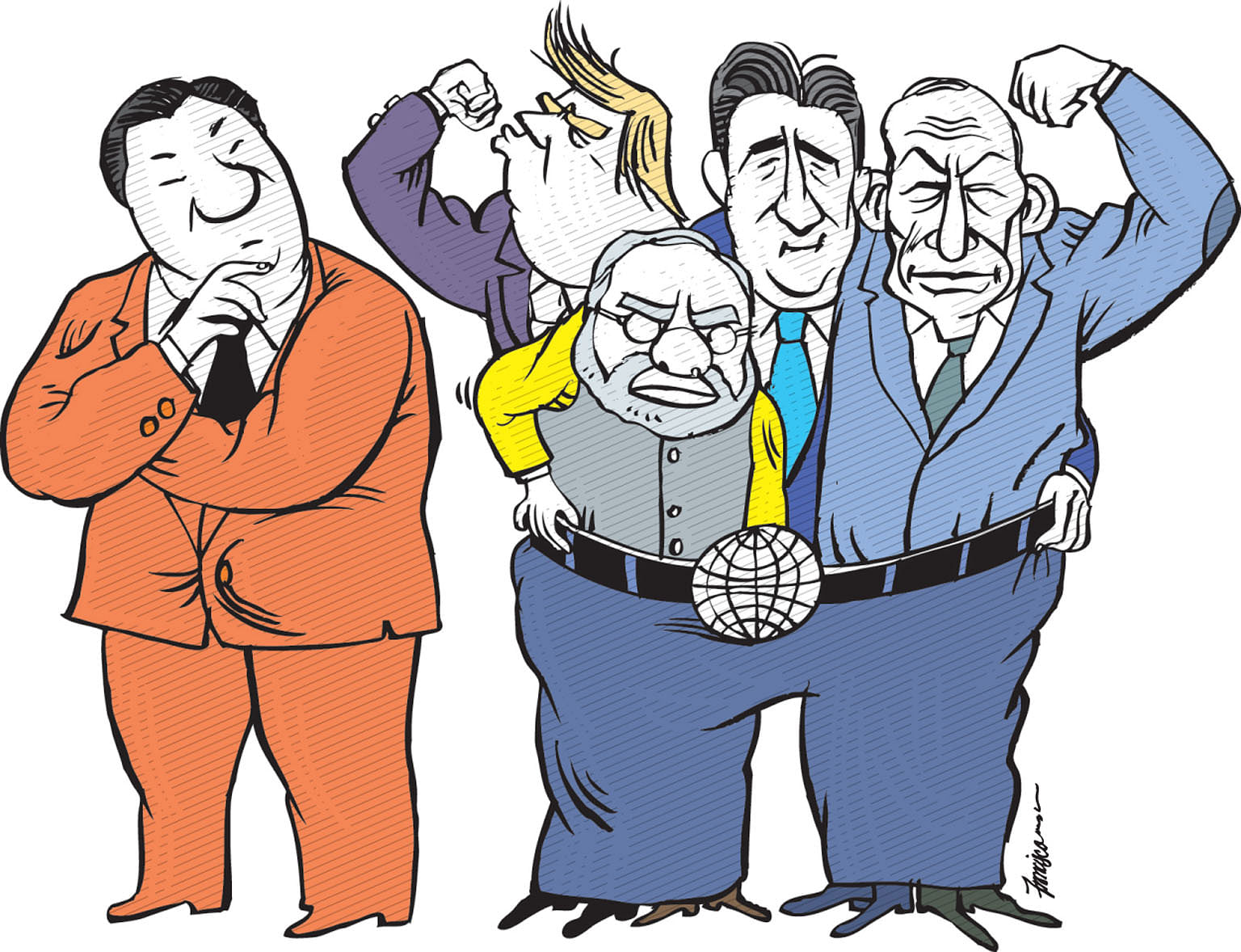The Australian government issued on Thursday a new foreign policy White Paper - the first since 2004 - which broke new ground in acknowledging the growing power of China and the risks that it poses for the US-led order in Asia, to which Canberra remains so strongly committed.
The key to its response to this major challenge is the concept of the "Indo-Pacific region". It is not a new idea, but it has new and growing significance as China's strength and strategic ambition become ever clearer, and America's become correspondingly less certain.
At its heart is the simple idea that China's power can be balanced and contained not just by America but also by India. It presupposes that South and East Asia together constitute a single strategic system in which China and India will inevitably compete for leadership.
If that was true it would make a big difference to Asia's future. That is because India has the potential, at least in the longer term, to add decisive strategic weight, alongside America, Japan and other countries, including Australia, and make it much easier for them to prevent China dominating East Asia. One can see the appeal to Canberra.
It is an idea that is increasingly popular in Washington too, for the same reasons. It was supposed to be a key theme of President Donald Trump's visit to Asia earlier this month.
When Mr Trump came to Asia, the last thing he wanted to talk about was China, and especially President Xi Jinping's determined campaign to build a new East Asian strategic order led by Beijing. He wanted to promote his atavistic obsession with bilateral trade balances, and his muscular approach to North Korea. He didn't want to take on Mr Xi.
But his advisers knew the new President needed to say something to reassure his Asian hosts about his strategic commitment to the region. They understood there is concern not just because Mr Xi, after last month's 19th Party Congress, is looking more ambitious and powerful than ever. They are worried too because Washington under Mr Trump looks even weaker and less certain in confronting China than the Obama administration proved to be.
Mr Trump's team had scrapped his predecessor's half-baked "Pivot to Asia" back in March, but had offered nothing in its place. So, in the lead-up to Mr Trump's visit they sought to use the trip to burnish America's regional leadership credentials by talking up a US vision of a "free and open Indo-Pacific".
That concept was to be backed up by the so-called "Quad", which envisages that the Indo-Pacific's four leading democracies - America, India, Japan and Australia - will cooperate to ensure the region remains under US rather than Chinese leadership.
This too is not a new idea. Australia was enthusiastic when the idea was first floated a decade ago, but it pulled out in 2008 because of fears that the Quad would be seen in Beijing as an attempt to contain China's ambitions - which of course it was.
Although it is perhaps Washington's most loyal ally, Canberra long ago became very sensitive to any suggestion that it was siding with Washington against Beijing. No one in Canberra wants to risk that because Australia's economy has flourished thanks to a boom in trade with China.

That delicate balancing act began in 1996 when then Prime Minister John Howard promised that nothing Australia did as a US ally would be directed against China.
His successor Kevin Rudd dropped the Quad rather than risk displeasing Beijing, because he feared China would see it as violating Mr Howard's promise. Since then all Australian political leaders have trod a fine line between supporting Washington and placating China.
One of Mr Rudd's successors, Tony Abbott, once described Australia's approach to China in three words: "Fear and greed".
The fact that the present government of Malcolm Turnbull has been willing to risk China's anger to embrace the Quad shows how Australia's worries about China are growing. Indeed the new White Paper goes further than the Quad and makes much of the need for Australia to align with democracies in Asia - not just India and Japan but Indonesia and South Korea - to promote and support US leadership in the region.
An earlier sign of growing anxiety came in June, when Mr Turnbull delivered a major speech in Singapore in which for the first time an Australian political leader acknowledged that China seeks to overturn the US-led regional order.
That's hardly news of course. China's ambitions have been obvious ever since Mr Xi started to talk about China's aim to build a "new model of great power relations" almost a decade ago.
But until this year Canberra's political leaders have kept on reassuring Australians that they "don't have to choose between America and China" because China would not dare to challenge America for the leadership of Asia.
Now, thanks to Mr Trump, they are not so sure.
He makes it much harder to assume, as Canberra has done for so long, that Washington has Beijing's measure and will be able to contain China's ambitions without any real help from Australia or others on this side of the Pacific.
The new foreign policy White Paper went further than Canberra has ever gone before in acknowledging uncertainty about America's commitment to Asia.
So Canberra increasingly sees the need to offer Washington more tangible encouragement and support, even if that risks angering Beijing. Hence it has endorsed Mr Trump's vision of a free and open Indo-Pacific, and embraced the revived Quad by sending a senior official to the meeting in Manila.
Indeed Canberra seemed more enthusiastic than Mr Trump himself. Despite the clear signals from Washington that the Indo-Pacific and the Quad would be the trip's major themes, Mr Trump only mentioned them once and in passing while he was in Asia.
His conduct in Beijing, almost obsequious at times, made it clear he is not inclined to block Mr Xi's ambitions in Asia. He raised none of the concerns about China's assertive conduct, for example in the South China Sea, that has become the focus of US-China rivalry. He seems happy for China to become the region's leading power in America's place.
And if that's wrong, and Mr Trump is serious about containing China as Canberra would like, then he will need much more powerful ideas, backed by much more decisive action, than the old leftovers that his advisers served up for this trip.
The "Indo-Pacific" concept is much more an expression of hope than of geo-strategic reality; it is premised on the hope that India will have both the power and the motive to intervene decisively to support America against China to prevent it dominating East Asia. That seems most unlikely.
The reality is that India and China occupy two separate strategic spaces - the South Asian/Indian Ocean region on the one hand and the East Asian/Western Pacific region on the other. There is no reason to assume India will try to contest China's position in East Asia, or that China will seriously contest India's in its region.
For both of them, the costs of taking on such a powerful rival far from their own shores would outweigh any possible advantage. So it makes no sense to rely on India to solve anyone's fears of Chinese ambitions in East Asia.
And for the same reason, the Quad will never help to contain China's ambitions unless the four countries involved are willing to pay real costs, and sacrifice their own ties with Beijing, to support one another against China's pressure. And how likely is that?
Would India, or Australia, ever risk its own interests in good relations with Beijing to offer Japan anything more than rhetorical support in a confrontation with China in the East China Sea?
So if these ideas are the best Washington can offer to contain China's power and ambition, Canberra has to think again.
- The writer is professor of strategic studies at the Australian National University in Canberra.


